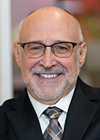Preparing the Next Generation of DOs
Published October 22, 2020

From the President
Robert A. Cain, DO
President and CEO
American Association of Colleges of Osteopathic Medicine
Colleagues,
This week is National Health Education week. I’ve spent some time reflecting on the changes we’ve adapted to in the past year, and how our role in preparing the next generation of doctors is more important than ever. These changes bring with them several opportunities to transform the way we approach medical education and use our present challenges to drive our profession forward.
I don’t need to tell you that the medical school curriculum is challenging. There’s a great amount of knowledge and training that’s packed into those four years, and every component seems essential to fully prepare our students for their careers. Public health has always been a part of this preparation, but perhaps not as emphasized as it was historically. Today’s struggles with the pandemic might serve as a reminder to us about its importance. As we continue to evolve and respond to today’s health crises, I see an opportunity to improve the way in which we prepare and engage our students.
One of the ways we’re doing this is through Students Assist America. We’ve been working to increase awareness of the ways in which our students can play a larger role in public health. Our students are learners, first and foremost. But along their way to becoming doctors, they’re gaining knowledge and skills that can benefit the public, and the students have proven that they can be a great asset when responding to a health crisis. A question I would like to pose to you is, how might we update our curriculum so that our students are better prepared to respond to challenges when they arise?
Students Assist America’s potential also lies in its ability to broaden our interprofessional collaboration. This initiative has allowed us to engage ten organizations across the field of health and medical education, each working side by side to find common solutions for our nation’s patients. As we learn how to mobilize our students and assist the public in the process, we’re finding opportunities to further collaborate with other fields to determine how their students can contribute to the public health response. Importantly, we are learning more about each other as professionals.
Change usually comes hard, and always with a certain degree of risk. I believe this might be why there’s a natural tendency to look back on what was, instead of what could be ahead. But our profession comprises many talented, dedicated individuals with lots of experience working through complexity to solve problems. We’re in the midst of some great changes. But I’m proud of the work you’re doing, and I would ask that you stay on the lookout for the opportunities we have, in the midst of our challenges, to transform our profession for the better.
